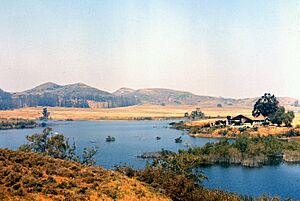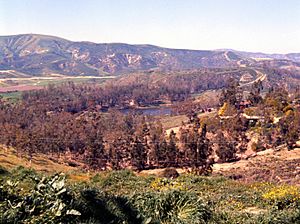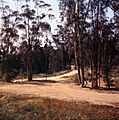Peters Canyon facts for kids
Peters Canyon Regional Park is a beautiful natural area in Orange County, California. It's a great place to explore the outdoors! The park covers 354 acres and is home to many different types of plants and animals. You can find coastal sage shrubs, areas near rivers, freshwater marshes, and open grasslands here. The park is located in both Orange and Tustin, California.
The Irvine Company gave Peters Canyon to the county in 1992. Before that, it was used for grazing cattle. Today, the canyon has homes on one side and open hills on the other. Many people love to visit Peters Canyon. Hikers, mountain bikers, and people riding horses often use the trails. These trails go around a 50-acre man-made lake. The Irvine Company built this lake in 1931. The park is open every day from 7:00 AM until sunset. However, it might close for a few days after heavy rain or dangerous weather.
The park is very popular because it's easy to get to, being in the middle of a suburban area. People also like how clean it is and the many different trails available. Park managers ask everyone to help protect the wildlife and support efforts to improve the park.
Contents
History of Peters Canyon
Peters Canyon Regional Park was once part of a very large Spanish land grant. This grant was called Rancho Lomas de Santiago. It was a huge piece of land, about 47,000 acres, given to Teodosio Yorba in 1846. The part that became Peters Canyon was known as "Canon de Las Ranas." This means "Canyon of the Frogs" in Spanish. It got this name because water from the canyon flowed into the "Cienega de Las Ranas," or "Marsh of the Frogs." Today, this marsh is known as Upper Newport Bay.
In 1897, a man named James Irvine bought the land from Yorba. He then leased parts of the land to farmers. One of these farmers was James Peters. Peters built a ranch house and planted a grove of eucalyptus trees. These trees were near a place called Little Peters Lake, which was in the lower part of the Canyon of the Frogs.
In 1899, people from Orange and Santa Ana started playing golf here. The Santiago Golf Club was built in Peters Canyon on land leased from the Irvine Company. The golf course had greens made from oil-soaked sand. The fairways were just the natural soil. A red clubhouse was built on a ridge near where the Upper Peters Canyon reservoir is now.
The Upper Peters Canyon reservoir was built in 1931. The lower reservoir, known as Little Peters Canyon Lake, was built in 1940. These reservoirs helped save water, which allowed farming, like growing orange groves, to grow in the canyon. Today, these reservoirs are part of the Peters Canyon Wash. This wash is part of the San Diego Creek, a 26-mile waterway that flows into Upper Newport Bay.
Camp Myford and Park Creation
During World War II, the United States Army used a training area in the eucalyptus grove near Little Peters Lake. This area was called Camp Commander. Soldiers stationed here would practice battles against soldiers from Camp Rathke, another Army post about two miles away.
From 1952 to 1988, the Boy Scouts used a place called Camp Myford for weekend events. Later, a gated community called Tustin Ranch Estates was built on part of the old Camp Myford site. However, on March 3, 1992, the Irvine Company donated 354 acres to Orange County. This land became Peters Canyon Regional Park, which is now a protected open space for everyone to enjoy.
Recreation and Activities
Peters Canyon is a popular spot for many outdoor activities. Hikers, mountain bikers, and people riding horses love the long trails. Some of the trails include Newport Boulevard Trail, Meadowlark Trail, Skypark Trail, and Lake View Loop Trail. The longest trail is about 5.5 miles long, roundtrip.
The Mountains-to-Sea Trail also passes through Peters Canyon. This trail is 22 miles long and stretches from Weir Canyon to Upper Newport Bay. It connects Peters Canyon to other wild parks nearby. Park rangers and local volunteers work hard to keep the trails in great condition.
Another fun activity in the canyon is birdwatching. More than one hundred different types of birds live here, including many waterfowl and birds that live near water. The park is also open to people riding horses and is friendly to dogs, as long as they are on leashes.
Wildlife and Habitats
The canyon is home to many different animals. You might see mule deer, raccoons, opossums, bobcats, and coyotes. Rattlesnakes are also present, so it's good to be aware. While mountain lion sightings have been reported, attacks are very rare. Besides larger animals, the canyon has many smaller amphibians, reptiles, and insects.
Over 100 species of migratory waterfowl and wading birds visit the canyon's reservoir throughout the year. Birds like cactus wrens, gnatcatchers, and rufous-crowned sparrows can be seen year-round in the park's different habitats.
The canyon also has a variety of trees and plants, both native and non-native. You can find rare black cottonwood trees, willows, oaks, sycamores, and different types of cacti, brush, and grasses along the trails. There's also a small eucalyptus forest in the southern part of the canyon. Farmer James Peters originally planted these trees.
The park has several important habitats. These include freshwater marsh areas, coastal sage scrub, grasslands, and sections along rivers. A small creek flows through the canyon during certain seasons.
The park believes that all visitors should help protect its wildlife. Because of this, fires are not allowed. Swimming or fishing in the creeks or reservoir is also prohibited. The park asks that children stay with an adult, and all dogs remain on their leashes.
Images for kids








